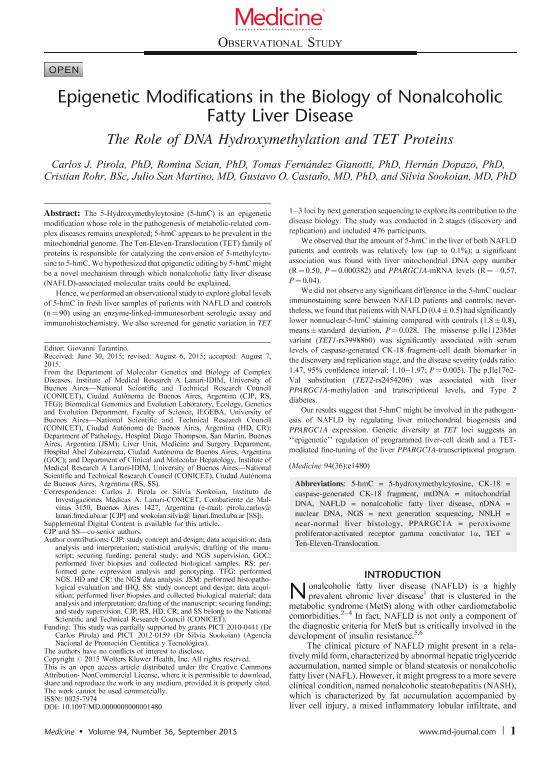Artículo
Epigenetic Modifications in the Biology of Nonalcoholic Fatty Liver Disease: The Role of DNA-Hydroxymethylation and TET Proteins
Pirola, Carlos José ; Scian, Romina
; Scian, Romina ; Fernández Gianotti, Tomás
; Fernández Gianotti, Tomás ; Dopazo, Hernán Javier
; Dopazo, Hernán Javier ; Rohr, Cristian Oscar
; Rohr, Cristian Oscar ; San Martino, Julio; Castaño, Gustavo Osvaldo; Sookoian, Silvia Cristina
; San Martino, Julio; Castaño, Gustavo Osvaldo; Sookoian, Silvia Cristina
 ; Scian, Romina
; Scian, Romina ; Fernández Gianotti, Tomás
; Fernández Gianotti, Tomás ; Dopazo, Hernán Javier
; Dopazo, Hernán Javier ; Rohr, Cristian Oscar
; Rohr, Cristian Oscar ; San Martino, Julio; Castaño, Gustavo Osvaldo; Sookoian, Silvia Cristina
; San Martino, Julio; Castaño, Gustavo Osvaldo; Sookoian, Silvia Cristina
Fecha de publicación:
09/2015
Editorial:
Lippincott Williams
Revista:
Medicine
ISSN:
0025-7974
Idioma:
Inglés
Tipo de recurso:
Artículo publicado
Clasificación temática:
Resumen
The 5-Hydroxymethylcytosine (5-hmC) is an epigenetic modification whose role in the pathogenesis of metabolic-related complex diseases remains unexplored; 5-hmC appears to be prevalent in the mitochondrial genome. The Ten-Eleven-Translocation (TET) family of proteins is responsible for catalyzing the conversion of 5-methylcytosine to 5-hmC. We hypothesized that epigenetic editing by 5-hmC might be a novel mechanism through which nonalcoholic fatty liver disease (NAFLD)-associated molecular traits could be explained. Hence, we performed an observational study to explore global levels of 5-hmC in fresh liver samples of patients with NAFLD and controls (n = 90) using an enzyme-linked-immunosorbent serologic assay and immunohistochemistry. We also screened for genetic variation in TET 1–3 loci by next generation sequencing to explore its contribution to the disease biology. The study was conducted in 2 stages (discovery and replication) and included 476 participants. We observed that the amount of 5-hmC in the liver of both NAFLD patients and controls was relatively low (up to 0.1%); a significant association was found with liver mitochondrial DNA copy number (R = 0.50, P = 0.000382) and PPARGC1A-mRNA levels (R = −0.57, P = 0.04). We did not observe any significant difference in the 5-hmC nuclear immunostaining score between NAFLD patients and controls; nevertheless, we found that patients with NAFLD (0.4 ± 0.5) had significantly lower nonnuclear-5-hmC staining compared with controls (1.8 ± 0.8), means ± standard deviation, P = 0.028. The missense p.Ile1123Met variant (TET1-rs3998860) was significantly associated with serum levels of caspase-generated CK-18 fragment-cell death biomarker in the discovery and replication stage, and the disease severity (odds ratio: 1.47, 95% confidence interval: 1.10–1.97; P = 0.005). The p.Ile1762Val substitution (TET2-rs2454206) was associated with liver PPARGC1A-methylation and transcriptional levels, and Type 2 diabetes. Our results suggest that 5-hmC might be involved in the pathogenesis of NAFLD by regulating liver mitochondrial biogenesis and PPARGC1A expression. Genetic diversity at TET loci suggests an “epigenetic” regulation of programmed liver-cell death and a TET-mediated fine-tuning of the liver PPARGC1A-transcriptional program.
Palabras clave:
Nafld
,
5hydroxymethyl-Citosine
,
Epigenetics
,
Tets
,
Genetics
Archivos asociados
Licencia
Identificadores
Colecciones
Articulos(IDIM)
Articulos de INST.DE INVEST.MEDICAS
Articulos de INST.DE INVEST.MEDICAS
Citación
Pirola, Carlos José; Scian, Romina; Fernández Gianotti, Tomás; Dopazo, Hernán Javier; Rohr, Cristian Oscar; et al.; Epigenetic Modifications in the Biology of Nonalcoholic Fatty Liver Disease: The Role of DNA-Hydroxymethylation and TET Proteins; Lippincott Williams; Medicine; 94; 36; 9-2015; 1480-1490
Compartir
Altmétricas



